Full Stack Development in the Age of AI: Building Intelligent Applications
Table of Contents
The landscape of full-stack development has shifted considerably over the past two years. What started as experimental integrations of machine learning models has evolved into a fundamental rethinking of how we architect and build applications. I’ve spent the better part of eighteen months working with teams transitioning from traditional full-stack patterns to AI-enhanced architectures, and the practical challenges we face tell a story quite different from the polished narratives in vendor documentation.
The New Stack Nobody Warned Us About
When people discuss AI integration in web applications, they tend to focus on the glamorous parts. Fine-tuning models, prompt engineering, and retrieval augmented generation. But the reality for most development teams involves wrestling with infrastructure problems that feel oddly anachronistic.Vector databases need tuning. Embedding pipelines breaks in production. Token costs spiral out of control because nobody thought to implement proper caching strategies.
Traditional full-stack development offered a reasonably stable mental model. You had your frontend framework, your backend API layer, a database, perhaps a cache and a message queue for good measure. The complexity was manageable because the components were well understood. Adding AI capabilities disrupts this equilibrium in ways that aren’t immediately obvious until you’re deep into implementation.
Consider a typical scenario: you’re building a customer support application with semantic search capabilities. Sounds straightforward enough. Your frontend captures user queries, your backend interfaces with an embedding model to convert text into vectors, you query a vector database for relevant documents, then pass context to a language model for response generation. Four new components in what used to be a two-tier application.
The architectural questions multiply quickly. Where do you host the embedding model? Do you use a managed service or self-host? What about rate limiting between your application and the LLM provider? How do you handle context windows when user conversations grow lengthy? Each decision carries implications for cost, latency, and system reliability.
Rethinking State Management
State management in AI-enabled applications presents challenges that frontend frameworks weren’t designed to handle. React’s state paradigm assumes relatively small, predictable data structures. But when you’re managing conversation history, retrieved document chunks, and streaming LLM responses simultaneously, you’re dealing with data volumes and update patterns that strain conventional approaches.
Some teams I’ve worked with attempt to shoehorn everything into existing state management solutions. Redux stores are bloated with conversation trees. Context providers re-rendering entire component subtrees because vector search results changed. The performance implications become apparent quickly, particularly on mobile devices where users expect responsive interfaces despite the heavyweight computations happening behind the scenes.
A more effective approach involves treating AI interactions as a distinct concern with its own state layer. This might mean implementing a dedicated store for conversation management, separate from your application’s primary state. Web Workers can handle embedding generation without blocking the main thread. IndexedDB provides local persistence for conversation history without overwhelming memory. These aren’t revolutionary techniques, but applying them thoughtfully makes the difference between a usable application and one that feels sluggish.
Streaming responses from language models introduce additional complexity. Your UI needs to handle partial updates gracefully, which requires careful consideration of rendering strategies. Token-by-token updates look impressive but can cause performance issues if you’re not batching DOM operations appropriately. Some applications benefit from buffering tokens and updating in chunks, sacrificing a bit of perceived immediacy for stability.
You May Also Read: State Management in Front-end Development: Redux vs Context API
The Backend Becomes a Coordinator
Backend architecture in AI applications shifts from simple request-response patterns to orchestration of multiple intelligent services. Your API layer becomes less about CRUD operations and more about coordinating workflows that might involve several model calls, data retrievals, and transformations.
Error handling requires particular attention. Language models fail in interesting ways. They might refuse to respond based on content policies, exceed token limits mid-generation, or simply timeout. Your backend needs strategies for graceful degradation. Maybe you fall back to a smaller, faster model when the primary one is unavailable. Perhaps you cache common queries to reduce API dependency. The specific approach matters less than having one at all.
Cost management can’t be an afterthought. Token-based pricing means every API call has real financial implications. I’ve seen proof-of-concept applications rack up thousands in API fees because developers treated model calls like database queries. Implementing request deduplication, response caching, and prompt optimization isn’t optional at a production scale.
Database design for AI applications diverges from traditional patterns. You’re likely running both a conventional database for structured data and a vector database for similarity search. Keeping these synchronized presents interesting challenges. When a user updates their profile, you might need to regenerate embeddings for their content and update multiple data stores atomically. Event-driven architectures help here, using message queues to ensure eventual consistency across your data layer.
Practical Integration Patterns
Several integration patterns have emerged as teams work through these challenges. The sidecar pattern, borrowed from microservices architecture, works well for AI capabilities. Your core application remains relatively unchanged, with AI features implemented as separate services that augment functionality rather than replacing existing logic.
This approach offers flexibility for experimentation. You can iterate on prompt engineering, swap embedding models, or adjust retrieval strategies without touching your main codebase. It also simplifies testing, since you can mock AI service responses and verify that your application handles various scenarios appropriately.
Another useful pattern involves progressive enhancement of traditional features. Take form validation. Basic checks happen client-side using conventional JavaScript. The backend performs standard validation as well. But you might also call an LLM to provide intelligent feedback on user input, catching edge cases that rule-based validation misses. If the AI service is unavailable, the application still functions with its baseline validation.
The key insight is that AI features should enhance rather than replace robust traditional functionality. This runs counter to the tendency to rebuild everything around AI capabilities, but it results in more maintainable and reliable applications.
Testing Strategies That Actually Work
Testing AI-integrated applications requires adapting your quality assurance approach. Unit tests for deterministic code remain straightforward. But how do you test a feature whose output varies with each invocation?
Snapshot testing proves surprisingly useful. You can’t expect identical outputs, but you can validate that responses maintain the expected structure and contain the required elements. Property-based testing helps verify that certain invariants hold regardless of the specific model output. For instance, if you’re building a summarization feature, tests might verify that summaries are shorter than the source text and contain no hallucinated entities not present in the original.
Integration testing becomes more challenging when you’re dependent on external AI services. Most teams use a combination of recorded responses for routine testing and occasional live integration tests to catch API changes. This isn’t perfect, but it balances testing thoroughness with practical constraints around cost and reliability.
You May Also Read: Why MERN and AWS Are the Future of Full-Stack Development
Looking Forward Without Hype
The integration of AI capabilities into full-stack development isn’t a temporary trend, but the path forward remains somewhat unclear. New models appear regularly with different capabilities and constraints. Infrastructure tooling continues maturing. Best practices are still being established through trial and error.
What seems certain is that treating AI as just another API to integrate misses the deeper implications for how we design and build applications. The patterns, architectures, and mental models that served us well in traditional full-stack development need refinement. Understanding these changes and adapting our practices accordingly will determine which teams successfully navigate this transition and which struggle with unstable, expensive, and ultimately unsuccessful AI implementations.
The work of building intelligent applications is less about mastering any particular framework or model and more about developing sound engineering judgment for a new class of architectural decisions. That’s the real challenge, and the real opportunity.

















